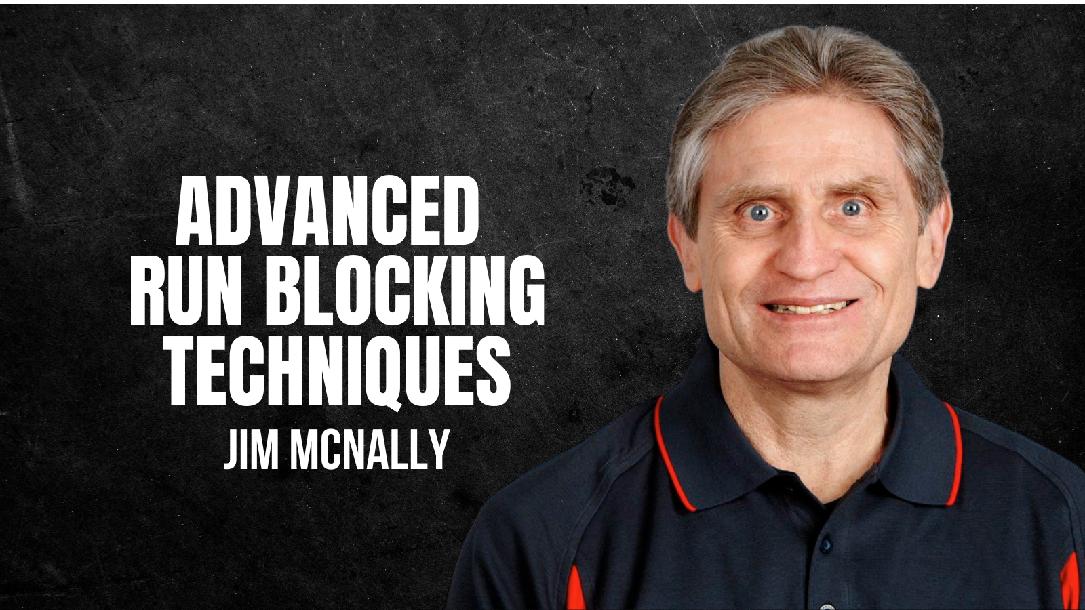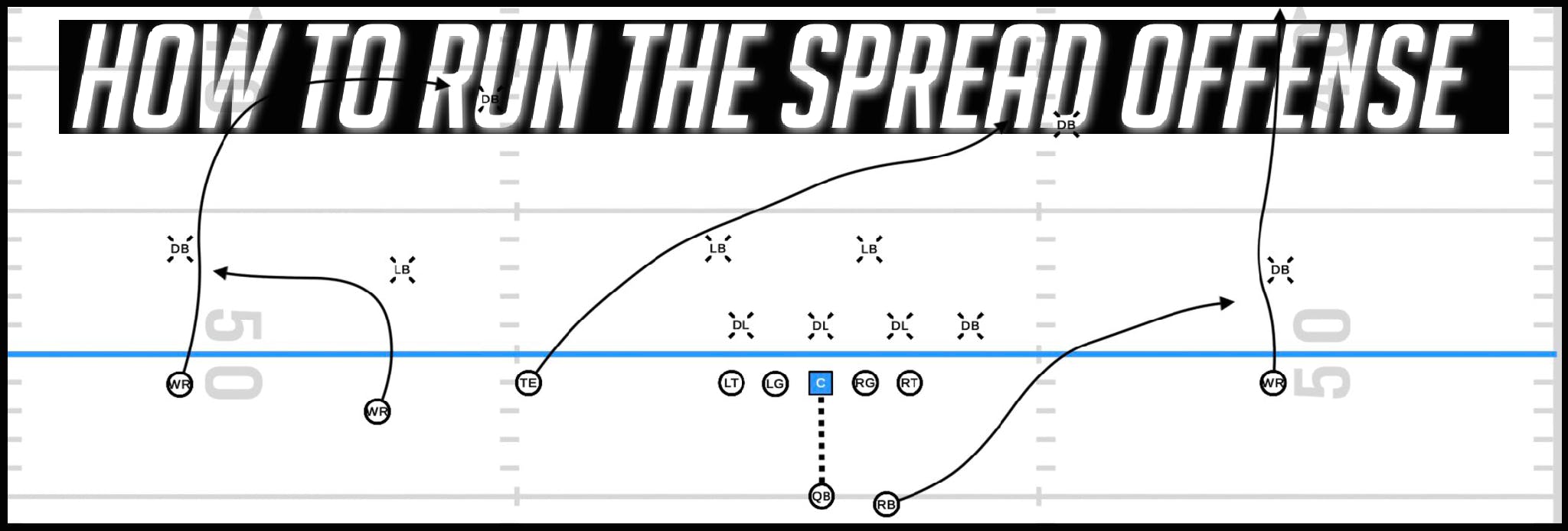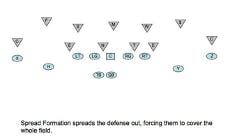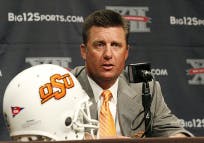The Future of American Football: How to Run the Spread Offense
In recent
years, one of the major topics debated across college sports is whether a
team should run a pro-style or spread offense. There are obviously pros
and cons with running each. We’ve seen teams like Baylor and Oregon
take the spread to a whole new level and create some of the most dynamic
offenses in the history of college football. While critics may argue it
doesn’t prepare players adequately for the next level, I think I
wouldn’t be alone in saying the spread can provide benefits at the NFL
stage. Throughout this article, I’ll break down some of the
interdependencies of the spread offense and show how Chip Kelly and
other football coaches utilized it to the max.
The Basics
Ultimately,
I believe the future of modern football will be heavily impacted by the
spread offense. The up-tempo nature of it is loved by players and fans.
Rather than the older way of offenses reacting at the line of scrimmage
to the defense, it is the other way around. However, this time defenses
have a lot less time to adjust. While conditioning is important for a
team running the spread, particularly the offensive lineman, it also
important to have depth. By running in receivers and backs consistently,
guys are able to stay fresh. Another basic point about the spread is
the presence of a quarterback that can scramble. You don’t necessarily
need Michael Vick, but some mobility would be nice.
No-Huddle
While
the spread can be run with huddles, I believe it is the most effective
when used in a no-huddle situation. The no-huddle emphasizes some of the
points above, such as conditioning and making it difficult on the
defense. However, it also requires discipline. There are many critical
points in reference to the no-huddle. First off, after each play, a
player needs to get the ball to the referee immediately to get the ball
spotted. The New England Patriots have perfected this at the
professional level. Although they don’t have the most mobile quarterback
in Tom Brady, he can flat out run a no-huddle offense.
The Origin of the Spread
The
spread offense was created by Rusty Russell (pictured to the right),
who coached the Fort Worth’s Masonic Home and School football team in
1927. One of the main reasons why he implemented it was due to lack of
size of his players. This is one of the reasons why I believe so many
teams utilize it. Not every team can recruit all of the most
physically-gifted athletes. So, to provide a solution to this problem,
they speed the game up. Various other forms of the spread have evolved
since Russell’s initial trials. Some of these include TCU coach Leo
Meyer in 1952 and Middletown High School coach, Glenn Ellison, with his
Run and Shoot Offense. It then began to take shape in the United States
in the late 1980s. It quickly spread throughout the college and high
school level.
Defensive Adjustments
One
of the primary ways to combat the speed witnessed in a spread offense
is to respond with speed. In the past, football teams have used four or
five defensive lineman for traditional sets. However, this isn’t nearly
as effective in stopping a spread, because it is simply not fast enough.
As a result, coaches have implemented formations, such as 3-3-5
defense. By combatting the spread offense with faster players, all of
sudden blocking assignment issues can arise. Further, it is important to
have a strong defensive line that can create pressure on a quarterback,
despite the lack of rushers. Bringing outside linebackers off the edge
can also assist in generating more quarterback hits.
Not only are
high school programs implementing these defenses, but many large
colleges are as well. Texas Christian and West Virginia are two of the
primary ones, as each of the programs has increased their emphasis on
speed on the defensive end. Ironically, both of these teams also have
been strong proponents of instituting the spread on the offensive side
of the ball.
Other Forms of the Spread
Although
many just refer to the spread as a quarterback in the shotgun position
with a plethora of receivers on the field, recent years have seen
coaches institute new forms of the spread. Here are some of the more
common ones:
1. Air Raid – Current
Oklahoma State football coach, Mike Gundy, has employed and perfected
the air raid version of the spread. Gundy sees these wide-open attacks
as a way that can not only put up points in a hurry and create wide-open
attacks, but also something that can prevent injuries. Gundy praised
the offense stating, “We’re spread out. We’re throwing it around and
catching it. There’s not as many collisions compared to putting
everybody together tight and ramming everybody up in there and being a
pile.”
2. Spread Option –
In a different way than the heavy passing of the air raid offense, the
spread option looks to run the ball first. As a result, offensive
lineman must possess the ability to pull outside, receivers must be
willing to block, and the quarterback should be able to tuck it and run
in certain situations. Current Arizona football coach Rich Rodriguez has
always been a strong proponent of the spread option and has quickly
made it popular across various football levels. A lot of the decision
making here rests on the shoulders of the quarterback, who must gauge
the defensive end’s movements to either tuck it or pitch it out to the
halfback.
3. Pistol – Chris Ault
developed this offense during his stay at Nevada. Current NFL star,
Colin Kaepernick, ran this offense with a high level of effectiveness
while at Nevada. The key behind this is having multiple players that can
run the ball. It has a different set-up, as to where the quarterback
and running back lines up.
Elite Spread Coaches
Many
coaches have achieved success using the spread offense, but for players
and coaches looking to use it, they should watch film from Chip Kelly
and Art Briles.
Chip Kelly – The
revolutionary football coach that made the spread so popular during his
stay at Oregon has brought that mentality to the professional level with
the Philadelphia Eagles. Despite getting some heat from football
analysts for some of his personnel moves with the Eagles, there is no
debating the fact that the man can coach football. The NFL has become a
pass-happy league, but Kelly took advantage of the spread option
offense. The thing that many find so impressive with Kelly is the fact
that he always seems to have something new up his sleeve. During his
stay in Philadelphia, we have seen the success, but also some stumbling
blocks.
Art Briles – The
current Baylor coach started tinkering with the spread while serving as
a high school coach in Texas. While initially he added part of it into
his scheme, it didn’t take long for him to make his spread the offense
all the time. While playing behind dynamic quarterbacks such as Robert
Griffin III, Briles focused on the fast pace nature of the spread to
create havoc amongst the opposing defenses. Former Baylor quarterback
Nick Florence said, “We practiced faster than we play and that’s how
you’ve got to do it. You get out there and you try to run 90 to 100
plays in practice. When you get in the game, the game actually feels
slow.”
The Future
Ultimately,
I believe the spread will continue to take over football. In today’s
game, players are coming into the college level faster than ever.
Coaches need to take advantage of these qualities and use it to pick
apart defenses. As evidenced above, there are many ways to utilize the
spread. Whether it’s running Gundy’s air-raid attack that may result in
50+ pass attempts a game or Kelly’s spread option that results in one of
the most balanced attacks in all of the NFL, coaches are taking note.
The exciting thing about the spread is that coaches will continue to
tinker with it and add in their own unique twists to add even more
differentiation to football.












